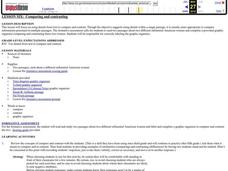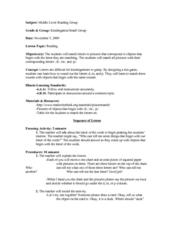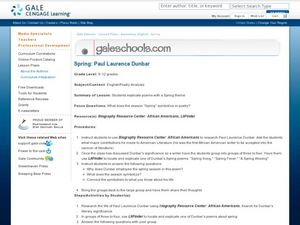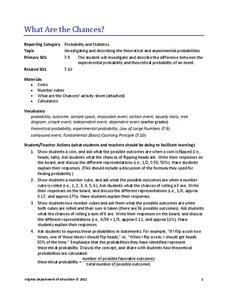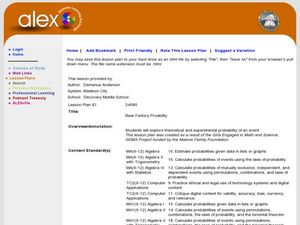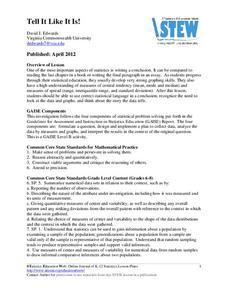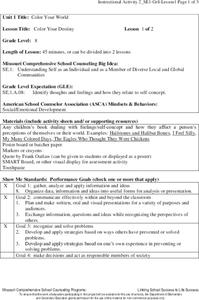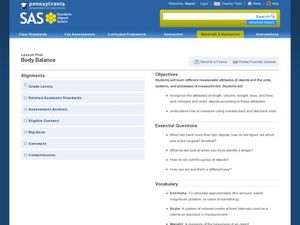Curated OER
Alexander and the Terrible, Horrible, No-Good, Very Bad Day
Second graders interact with the story of Alexander's horrible day by connecting it to their lives. They practice predicting, writing paragraphs, reading aloud, discussing his problems, making a card to cheer him up, and designing a pair...
Alabama Learning Exchange
Mix it Up! Exploring the Commutative and Associative Properties of Addition
Examine commutative and associative properties with your class. They'll explore the relationships between addition and subtraction and investigate patterns as they solve addition problems. Links to an assessment and a table game are...
Curated OER
Comparing and Contrasting
Analyze historical biographies. Young scholars compare and contrast the biographies of Susan B. Anthony and Pat Nixon. They construct graphic organizers, answer critical thinking questions, complete a formative assessment.
Curated OER
Reading Group-Beginning Sounds
Kindergarteners study beginning letter sounds in this interactive plan. They will match picture cards to the letter sound that each image begins with. After working together as a whole group, pupils participate in a game in which they...
Curated OER
Spring: Paul Laurence Dunbar
Explore the abundance of spring, no matter what season you are covering in your class! Using the poetry of Paul Laurence Dunbar, GALE Biography Resource Center, and Litfinder, pupils work on researching the poet and analyzing the use of...
Virginia Department of Education
Factoring for Zeros
Relate factors to zeros and x-intercepts. Scholars first graph quadratics in both standard and factored forms to see that they are the same. They go on to use the graphs to see the relationship between factors and x-intercepts.
Virginia Department of Education
What Are the Chances?
Take a chance on an informative resource. Scholars conduct probability experiments involving coins and number cubes to generate data. Compiling class data helps connect experimental probability to theoretical probability.
Alabama Learning Exchange
Bear Factory Probability
By examining a set of dice roll data, statisticians determine the probability of different sums occurring. They visit an interactive website and determine how many different vacation outfits Bobbie Bear will have based on the colored...
Curated OER
Story Retelling
Students explore storytelling by participating in an image analysis activity. In this story structure lesson, students read the book Cookie's Week by Tomie dePaola and retell the story to their teacher in sequential order. Students...
Curated OER
Comprehension
Fifth graders take part in a panel discussion. In this character lesson students show their understanding of the connection between events in a story and the development of characters. Students provide evidence from the story to support...
Curated OER
Assessing Normalcy
Learners define normal distribution as it relates to the bell curve. In this statistics lesson, students use the central tendencies of mean, median and mode to solve problems. They plot their data and draw conclusion from the graphs.
Curated OER
Journey to Japan: An Elementary Geography Standards-Based Unit on Japan
Second graders compare and contrast Japanese customs and culture to those of Americans through research in this year long study. They determine the basic needs of all people in spite of cultural differences.
Curated OER
Power Blackout Assessment
Learners discuss the importance of power grids in power generation. In this physics lesson plan, students explain the impact of power failure. They investigate the power blackout in 2003 and discuss their findings.
Curated OER
Assessing the Character of the Colonies: Rules of Civility and Decent Behavior
Students read a primary source document about the rules of civility and behavior in the presence of company. Using the text, they make assumptions about how life was like in the colonies. They compare and contrast the culture of the...
NASA
Connecting Models and Critical Questions
Scholars use data to analyze and determine which sets of information need to be counted. They create a model to explain differences among chemical elements using graphs to prove concept mastery.
Mathematics Assessment Project
Representing Quadratic Functions Graphically
Sometimes being different is an advantage. An engaging activity has scholars match cards with quadratic functions in various forms. Along the way, they learn about how each form highlights key features of quadratic functions.
California Department of Education
Who Am I?
Get in touch with your sense of self! The fifth and final lesson plan in a series of college and career lessons for fifth graders reinforces the relationship between interests and career choices. Pupils play a scenario-driven game, then...
California Department of Education
How to Succeed in Life
Is it possible that six simple traits lead to a happy, successful life? Part four of a six-part series of college and career readiness lessons examines the effects of character in determining success. Working groups discuss...
EngageNY
Normal Distributions (part 2)
From z-scores to probability. Learners put together the concepts from the previous lessons to determine the probability of a given range of outcomes. They make predictions and interpret them in the context of the problem.
Teach Engineering
Forms of Linear Equations
Linear equations are all about form. The fifth part in a unit of nine works with the different equivalent forms of linear equations. Class members become familiar with each form by identifying key aspects, graphing, and converting...
American Statistical Association
Tell it Like it is!
Scholars apply prior knowledge of statistics to write a conclusion. They summarize using correct academic language and tell the story of the data.
Missouri Department of Elementary
Color Your Destiny
Class groups bring feeling words alive by creating a poster that illustrates with images and colors, but not words, the feeling conjured by the word. The posters are then combined into a mural for the classroom wall.
Missouri Department of Elementary
Survivors
Developing a positive self-concept can sometimes be a challenge. Seventh graders engage in an activity that helps them identify their individual strengths and helps them recognize how these strengths can contribute to being a successful...
Curated OER
Body Balance
Examine measurable characteristics of objects to build an understanding of the different ways you can discuss an object's size when comparing it to other objects. After whole group instruction, the class compares and organizes several...


